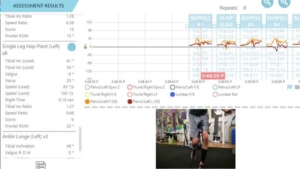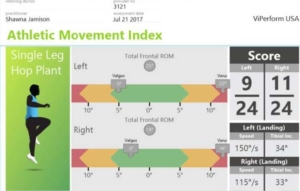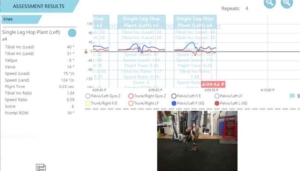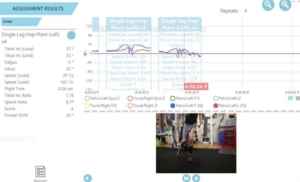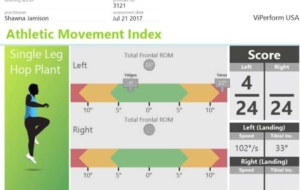Clinical Reasoning When Taping Biomechanically Demonstrated In This Single Case Study Investigating Hip And Knee Taping For Dynamic Knee Valgus
The Problem
35-year-old male with 17-year history of left sided L3/4 nerve root compression resulting from disc protrusion. Managed conservatively and has intermittent pain but has had consistent weakness in quadriceps.
The Investigation:
ViPerform motion analysis by DorsaVi was used to provide information regarding frontal plane and sagittal plane motion, more specifically magnitude and velocity of frontal plane motion (generally looking at control of dynamic valgus at the knee) along with tibial inclination. The functional movement assessed was single leg hop/land and the subject was assessed with no tape, Dynamic Taping into knee extension (to resist the collapse of the knee into flexion under the weight of the body) and Dynamic Taping into hip extension, external rotation and abduction to resist movement in the opposite directions. Multiple repetitions of each condition were performed, and the mean values reported.
The Results:
In the untaped condition total frontal plane motion was 25º and speed on landing was 150º/sec. Tibial inclination on landing was 34º.
With Dynamic Taping for knee extension total frontal plane motion was reduced to 19º and the speed on landing was reduced to 124º/sec. Tibial inclination on landing was reduced to 31º.
With Dynamic Taping to resist hip flexion/adduction/internal rotation total frontal plane motion was unchanged at 25º but speed on landing was reduced dramatically to 102º/sec (the most deceleration ever recorded by the DorsaVi consultant). Tibial inclination on landing was much the same as the untaped condition at 33º.
The Conclusion:
Dynamic Taping for knee extension to provide a resistance to the knee collapsing into flexion resulted in reduction in magnitude and velocity of frontal plane motion and reduced tibial inclination suggestive of less need to flex the knee to absorb load on landing nor to compensate in the frontal and transverse planes. The unique properties of Dynamic Tape Global however still permitted the same amount of flexion to occur in preparation for the jump and thereby does not appear to interfere with correct performance of the task.
Dynamic Taping of the hip to resist adduction, internal rotation and flexion resulted in a larger deceleration of movement into those directions however the magnitude of frontal plane motion remained the same. Presumably, this is because the deficit was knee extensor strength. As this sagittal plane motion was not addressed with hip taping, the compensation still occurred in the frontal plane albeit decelerated maximally due to the resistance of the tape (which would alter the kinetics associated with Dynamic Valgus at the knee). Again, the ability to perform the task was not hindered.
Studies by Bittencourt et al, 2017 (http://dx.doi.org/10.1136/bjsports-2016-097372.36) and Robinson et al, 2019 (https://doi.org/10.1016/j.gaitpost.2019.02.031) also demonstrate that Dynamic Taping reduces velocity and magnitude of hip adduction and internal rotation in single leg squat and gait.
This current investigation highlights however that as clinicians we must determine the underlying cause of the aberrant motion and address that. In this case, additional knee extension moment was required and taping to create this force externally reduced the compensatory hip motion also. Don’t just tape the hip because the movement is occurring there. Ask, why?
The Relevance:
Quadriceps weakness is often a sequelae post-surgery for anterior cruciate repair and total knee replacement. Increasing dynamic valgus at the knee is predictive of both initial and recurrent non-contact ACL ruptures and has been suggested as a contributing factor in Greater Trochanteric Pain Syndrome (GTPS), Patellofemoral Pain Syndrome (PFPS) and Patella Tendinopathy.
The ability to apply a force externally to reduce demand on the body thereby improving control of inner range of knee extension and frontal plane motion not only serves to improve function and functional loading immediately but may also be beneficial in scaling magnitude and rate of application of load, re-educating the desired technique or managing pain where this pain is load dependent as is generally the case with tendinopathy, all of which may aid intrinsic force generation.
If deficits are identified on assessment and are deemed to be a relevant contributing factor, Dynamic Taping may provide a way to immediately alter this both as part of management but also to furnish further information to support or challenge your hypothesis.
DorsaVi Reports
Untaped Condition
Knee Extension Taping
Hip Ab/Ext/ER Training


